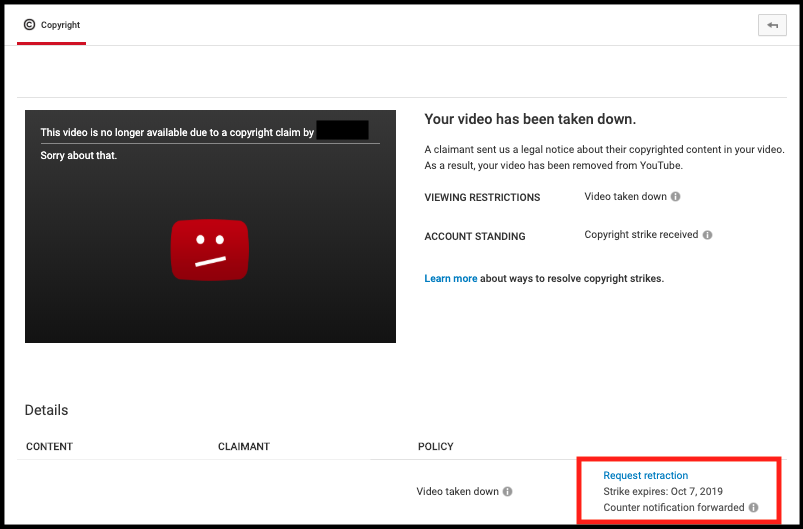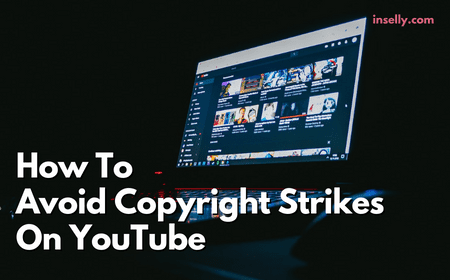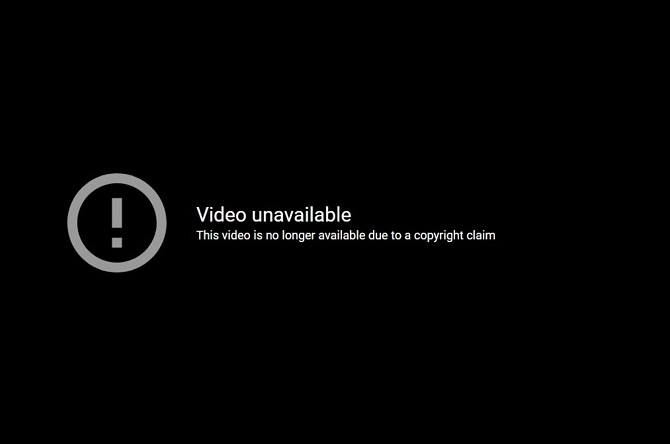YouTube has become a platform where creators share their thoughts, talents, and insights with millions. However, navigating the intricate world of copyright can be daunting. A copyright strike is a serious matter that can come with significant repercussions for your channel. Not only can it affect your channel’s standing, but it can also lead to suspension or even a complete ban if you receive three strikes within a 90-day period.
So, what does a copyright strike mean? Simply put, it's an official complaint filed by a video’s copyright owner against a YouTube user who has violated their rights. Copyright laws protect original works, including music, videos, and graphics. When someone uses these creative works without permission or a valid license, that's where the trouble begins.
YouTube has strict policies to protect the intellectual property of creators. If you receive a strike, you’ll be notified through your YouTube Studio dashboard. In addition to restrictions on uploading, live streaming, or even monetizing your content, a copyright strike also comes with a warning that remains on your account for three months.
To avoid such strikes, it's crucial to understand YouTube's Content ID system. This system scans uploaded videos for copyrighted material. If a match is found, the copyright holder can choose to block the video, monetize it, or track its viewership statistics. The key takeaway? Always do your homework about the content you use in your videos.
Common Causes of Copyright Strikes

Let's get one thing straight: copyright strikes can be a creator's worst nightmare! And while some pitfalls are easy to avoid, others need more careful consideration. Here are some of the most common culprits:
- Using copyrighted music: Many creators inadvertently use popular songs in their videos without permission. Music is a frequent target for copyright claims, so it's crucial to use royalty-free tracks or obtain proper licenses.
- Clips from TV shows or movies: Think twice before including movie clips or scenes from your favorite shows. These are often protected under copyright law and can easily land you in hot water.
- Images or graphics: Just because you found an image online doesn't mean it's fair game. Always verify the copyright status of images before using them. Consider sources with a Creative Commons license or stock photo websites.
- Gameplay videos: While many gamers share their gameplay, some publishers are strict about allowing monetization or various forms of streaming, which can lead to copyright issues.
- Third-party content in your videos: If you're reacting to or analyzing another creator's video, ensure you’re adhering to fair use guidelines, which might not always be clear-cut.
In summary, avoiding copyright strikes on YouTube boils down to being informed and cautious. Before uploading content, take a moment to double-check what you're including in your videos to ensure it's either your original work or properly licensed. Your channel's health depends on it!
Also Read This: Why 123RF Is Ideal for Video Content Creators
3. Tips for Using Copyright-Free Content

When venturing into the world of YouTube, using copyright-free content is a fantastic way to create videos without the fear of copyright strikes. But, "how do I find this content?" you might ask. Let’s dive into some straightforward tips to ensure you're using copyright-free material effectively!
- Explore Public Domain Resources: Many timeless works are in the public domain and can be used freely. Websites like Archive.org or Pixabay offer access to music, images, and videos without copyright restrictions.
- Use Creative Commons Licensed Content: Creative Commons licenses allow creators to share their work with specified permissions. Always read the license type—some require attribution, while others may not allow commercial use.
- Look for Royalty-Free Music: If you need background music, consider platforms like Bensound or Incompetech that provide tracks under a royalty-free arrangement, often for just a one-time fee.
- Utilize Stock Video Sites: Services such as Pexels Videos and Videvo offer high-quality stock videos that you can use in your projects for free!
By following these tips, you're not just ensuring you're safe from copyright strikes; you're also contributing to a community that values creativity and sharing. Remember, peace of mind is just a few clicks away!
Also Read This: How to Slice Images on Cricut for Craft Projects
4. How to Properly Attribute Creative Commons Materials

Attributing Creative Commons materials correctly is crucial, not just to respect the original creator's hard work, but also to maintain your standing on YouTube! So how do you get it right? Let’s break it down.
Here’s a general format you should follow for attribution:
- Title: Provide the title of the work you are using.
- Author: Mention the creator's name. If possible, link back to their profile or website.
- Source: Include a link to the original work to direct your audience to its source.
- License: Clearly state the type of Creative Commons license, usually linked back to the license page. For example, “This work is licensed under a Creative Commons Attribution-NonCommercial 4.0 International License.”
Here’s an example:
“Sunset by Jane Doe is licensed under CC BY-NC 4.0. Source: janedoe.com/sunset”
When attributing in your YouTube video, it’s a good idea to include this information in the description box, so viewers can easily locate it. Adding these elements not only showcases your integrity but also encourages a culture of respect within the creative community!
Also Read This: Is Shutterstock Images Safe? Ensuring Trust and Legitimacy in Your Stock Photography
5. Best Practices for Editing Your Own Videos
Editing your videos carefully is crucial to avoid copyright strikes on YouTube. Following some best practices can help you create original content while ensuring compliance with copyright laws.
- Create Your Own Footage: Whenever possible, film your own videos. This guarantees that you control the material and eliminates potential copyright issues.
- Use Royalty-Free Music: If your video requires background music, always opt for royalty-free or Creative Commons licensed music. Websites like Epidemic Sound and Bensound offer excellent options.
- Obtain Permissions: If you want to use someone else's clips or music, ask for permission and keep a record of their consent. This can protect you from potential strikes.
- Avoid Trademarks: Be cautious with logos and trademarks. Even using a brand logo in your video can result in copyright claims, so consider creating your own distinct visuals.
- Utilize Fair Use Wisely: While the Fair Use policy allows for limited use of copyrighted material, it’s a slippery slope. Stick to short clips, comment heavily, and always add your unique take to the content.
- Thoroughly Review Content: Before uploading, do a final check of your video to ensure no copyrighted material is included unintentionally.
By incorporating these best practices, you'll not only minimize the risk of copyright strikes but also enhance the quality and originality of your videos!
Also Read This: Ultimate Guide to Downloading Images from Imago Images Platform
6. Monitoring Your Content for Compliance
Once your video is up on YouTube, the work doesn't stop there! Actively monitoring your content for compliance with copyright laws is essential to maintaining a healthy channel.
- Use YouTube's Content ID: YouTube has a system called Content ID that scans videos for copyrighted material. If it finds a match, you'll receive a notification. It's a fantastic tool for staying ahead of potential strikes.
- Check YouTube Analytics: Dive into your YouTube analytics regularly. It can provide insights into which videos have content issues and help you address them promptly.
- Respond to Claims Promptly: If you receive a copyright claim, respond quickly. Some situations can be resolved with a simple conversation or removal of the offending material.
- Stay Updated on Copyright Laws: Copyright laws can change, so staying informed about new regulations and adjustments to YouTube’s policies is imperative.
- Engage with the Community: Join forums or social media groups dedicated to YouTube creators. Sharing experiences and solutions can keep you informed about best practices and emerging challenges.
- Keep Backups of Your Work: Always maintain backups of your videos and any corresponding permissions. This can prove handy if any disputes arise regarding copyright ownership.
By continuously monitoring your content for compliance, you can catch issues early and safeguard your creative space on YouTube. It's not just about avoiding strikes—it's about creating a sustainable and successful channel!
Also Read This: Learn How to Use This LinkedIn Picture Downloader to Download Any Image
What to Do If You Receive a Copyright Strike
So, you've just received a copyright strike on your YouTube channel? Take a deep breath! It can feel daunting, but there are steps you can take to address the situation. Here’s a roadmap to help you navigate through it:
- Understand the Notification: The first thing you should do is carefully read the email from YouTube. It will outline the reason for the strike and any relevant details.
- Review Your Content: Go back and re-evaluate the video that was flagged. Think about whether you used copyrighted material without permission. Were there songs, images, or video clips that might have triggered the strike?
- Check Your Options: Depending on the circumstances, you may have a couple of options:
| Option | Description |
|---|---|
| Remove the Content | If you believe the strike is justified, consider deleting the video to avoid further penalties. |
| File a Dispute | If you believe you have a fair use claim or other grounds to contest the strike, you can file a dispute directly through the YouTube platform. |
Either way, it's crucial to learn from this experience. Be sure to explore ways to create original content or use royalty-free resources moving forward!
Resources for Further Learning
If you're looking to dive deeper into copyright laws and safe content creation practices for YouTube, you’re in the right place! Here are some fantastic resources that can broaden your understanding and keep your channel safe:
- YouTube Creators Academy: This is an excellent starting point. They offer tutorials that cover various topics, including copyright and best practices when using someone else's content.
- Copyright.gov: The U.S. Copyright Office provides comprehensive information about copyright laws, including what constitutes fair use.
- Music and Art Libraries: Consider exploring places like Freepik or Bensound for royalty-free music and images that you can safely use in your videos.
- Social Media Groups and Forums: Join YouTube creator groups on platforms like Facebook or Reddit, where members share their experiences and tips for staying copyright compliant.
Remember, educating yourself about copyright not only helps you avoid strikes but also fosters creativity. The more you learn, the better your chances of building a thriving YouTube channel!
 admin
admin








